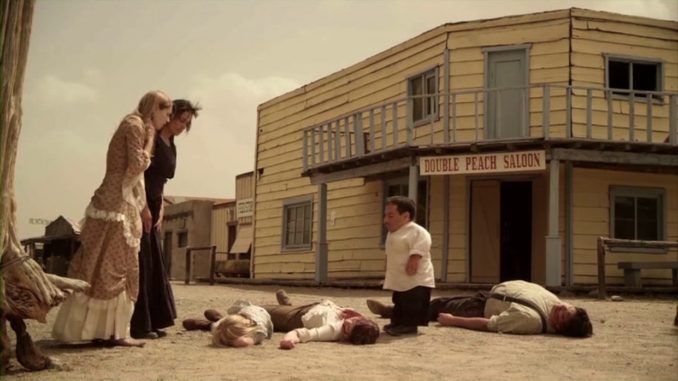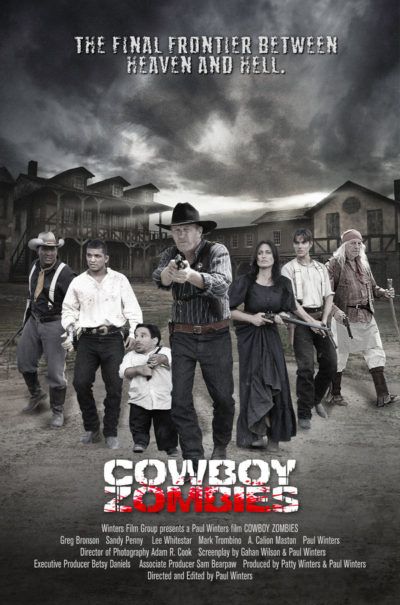
Rating: C-
Dir: Paul Winters
Star: Mark Grossman, Paul Winters, Greg Bronson, Sandy Penny
a.k.a. Walking Dead in the West
It’s 1876 in the Arizona Territory, and the small settlement of Crumpit has a problem. The dead are coming back to life. OK, colour me somewhat intrigued, because the combination of a Western with the zombie apocalypse isn’t one I’ve seen done particularly often in a feature. Exit Humanity would be the obvious one, and pre-dates this by a couple of years. This was also released under the rather cynical alternative title above, probably due to another film, Cowboys and Zombies, made in 2011… Which is also known as The Dead and the Damned. I hope that’s cleared everything up. But any confusion probably doesn’t matter much, since neither of them are essential viewing by all accounts.
This one, certainly, doesn’t do enough with the topic, and even at a terse 73 minutes (the IMDb gives a running-time of 86 minutes; I will not be seeking out a director’s cut), rather manages to outstay its welcome. It begins with Marshal Frank Wilcox (Winters) finding the outlaws he gunned down won’t stay that way. Meanwhile, in Crumpit, the hanging of two other miscreants on the town gallows, doesn’t exactly go as planned either. As other corpses also return to life, the locals and Wilcox end up taking refuge in the Double Peach saloon, owned by Rose Ann (Penny). This is where things more or less grind to a halt, because Winters seems to confuse moving the plot forward, with lobbing in additional characters.
 These include, but are not limited to, an Apache Indian, a Mexican outlaw, a little person bartender, a Buffalo Soldier (though he is not, contrary to the reports of Mr. B. Marley, a dreadlock Rasta), the local preacher (Bronson), and so on. I also believe I heard somebody with a distinct Australian accent at one point, though whether this was deliberate, or just poor vocal suppression is unclear. It’s all too much, and though they all get a scene or two, none of them receive adequate development. Eventually, after a lot of sitting around in the saloon, there’s a plan to ride a railroad handcart out of town to Tucson. It doesn’t go well, though the movie ends abruptly, and without any real resolution.
These include, but are not limited to, an Apache Indian, a Mexican outlaw, a little person bartender, a Buffalo Soldier (though he is not, contrary to the reports of Mr. B. Marley, a dreadlock Rasta), the local preacher (Bronson), and so on. I also believe I heard somebody with a distinct Australian accent at one point, though whether this was deliberate, or just poor vocal suppression is unclear. It’s all too much, and though they all get a scene or two, none of them receive adequate development. Eventually, after a lot of sitting around in the saloon, there’s a plan to ride a railroad handcart out of town to Tucson. It doesn’t go well, though the movie ends abruptly, and without any real resolution.
On the positive side, the film looks better than I expected, especially when it escapes the confines of the saloon, which is typically over dark. [The town was largely filmed on location at the Cowtown Studios up in Carefree, on their Old West Backlot. The studio had been founded by stuntman Ron Nix in 1973, and though now apparently defunct, was used by productions such as Dead Man, starring Johnny Depp] Winters has a good ear for dialogue, and some of the individual moments are effective, such as young Wyatt (Grossman) debating with his girlfriend whether to go on a reconnaissance expedition with the other men. In the end though, it’s just too static to be effective, even allowing for the undead horse which the zombie genre has increasingly become, over the decade since this was made.
